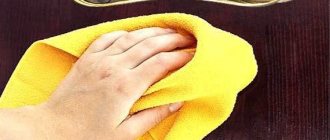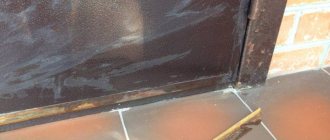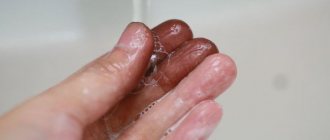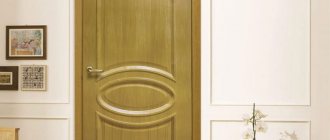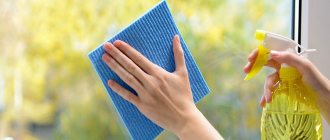When carrying out general cleaning, they wipe the dust, vacuum the carpets and even wash the windows, but they forget about the doors, but they should be given special attention! Germs accumulate on door handles, and greasy stains and fingerprints on the surface of the doors can ruin the entire interior. In this article we will look at how to clean interior doors correctly, taking into account what material the door is made of, what color it is and whether it has glass.
Types of contaminants and features of their removal
The methods of cleaning them depend on the type of contaminants. We list the main types of stains on interior doors:
- Mold . Moldy spots of mold are scraped off with a plastic scraper, the door is wiped with a damp cloth and allowed to dry, after which it is treated with a special product or vinegar.
- Old pollution . They can be removed both with folk remedies and with household chemicals.
- Hand stains . Can be removed with wet wipes, a rag or cleaners.
- Traces from felt-tip pens, markers and pens . They can be removed with glass washing liquid or special products, such as Profoam 2000.
- Plasticine . Clean with a weak alcohol solution.
- Nail polish . Remove with acetone or nail polish remover.
- Stains from sweet products (jam, honey, etc.) . Removed with soap and vinegar solution.
- Zelenka . Washable with vinegar.
- Oily spots . Can be removed with cleaning agents and vinegar solution.
Some door surfaces are sensitive to cleaning, so it is recommended that you follow proper cleaning procedures.
Rules for cleaning different materials
When starting to remove stains, you need to remember that doors made of chipboard, PVC or plywood require delicate care: they are easily damaged by abrasives due to the laminated top layer.
The protective and decorative surface is a paper-based film, so such doors should be cleaned very carefully. Laminated MDF coating is more unpretentious than chipboard or PVC, but it is also forbidden to clean it with abrasives. When cleaning, avoid getting water on a laminated door if it does not have a PVC edge - otherwise, the edge of the door may delaminate and the coating will be damaged.
As with MDF, when cleaning the veneer covering, you cannot use abrasive compounds, including washing powders. Products that contain acids, oils, alcohol, acetone, and alkalis can also damage the coating.
In modern interiors, interior doors with insert glass, including frosted glass, are becoming increasingly popular. When cleaning glass inserts, avoid concentrated ammonia and gasoline. And if ordinary glass can be cleaned with a window cleaner, the rough surface of frosted glass quickly gets dirty even from light touches, and there are certain nuances in caring for it: they can only be cleaned with soft microfiber cloths or cotton cloth and not allowed contact with abrasives.
Fluorine-containing compounds are strictly prohibited for cleaning frosted glass. Fluorine leads to the decomposition of the adhesive substances of the matte layer, disrupting the texture of the glass.
How to wash interior doors
The door needs to be properly cared for. Periodically lubricate and adjust hinges and locks. Rinse the glass inserts with cool water, adding a few drops of ammonia to it.
Clean metal inserts with soapy water. To prepare it, dilute 100 g of grated soap and 200 g of soda into one bucket of water. Moisten a napkin in the solution and treat the handles, decorative inserts, curly elements and the rest of the surface.
Use only soft cloths to wipe doors. Microfiber cloths are best for this.
If possible, treat frequently touched areas with a weak disinfectant solution.
The influence of color on the choice of cleaning method
Doors in light shades (milk oak, bleached oak, etc.) are convenient because micro-scratches and dust are almost invisible on their surface.
Light-colored doors are easier to clean than dark ones—there are no streaks left on their surface. For cleaning, you can use both special products and homemade compositions. To clean a light-colored door, you can make a polish at home:
- Three teaspoons of melted granulated wax are mixed with 200 ml of vegetable oil.
- The mixture is thoroughly kneaded until a homogeneous mass is formed and left for 15 minutes to cool to room temperature.
After the polish has cooled, you can begin cleaning: apply the mixture to light-colored doors with a dry, clean cloth, rubbing the surface until perfectly smooth. This homemade composition is suitable not only for cleaning light-colored doors from greasy fingerprints and stubborn dirt, but also for polishing.
Doors of a dark color, including wenge, are more difficult to clean, but at home you can prepare a special polishing composition that will not harm the surface:
- You need to mix 1 teaspoon each of lanolin and turpentine.
- Add 4 teaspoons of soy or other vegetable oil and a few melted beeswax granules.
- The ingredients are mixed until smooth.
The mixture is rubbed into the contaminated area with a soft cloth and wiped gently.
How to treat wood and metal surfaces
A wooden door requires meticulous care, as well as high-quality processing during its creation. These factors will help preserve the canvas from moisture, fungus, mold, small pests, and cracking.
Step-by-step processing of wooden canvas from scratch:
- Before starting processing, the door is sanded with fine sandpaper. To eliminate large defects, use a coarse abrasive. In difficult cases, the surface is puttied.
- After preparatory work, it is customary to impregnate the wood with abiotics, which are antifungal and anti-mold agents. They are applied like regular paint with a brush or roller. If the solution is well absorbed, then you can soak the door a second time a day later. The abiotic penetrates deep into the structure and protects the door for many years.
Note: you can putty the door after applying the abiotic.
- When the door is completely dry, it is re-treated with sandpaper.
- Before painting, the canvas is covered with a double layer of primer. Use either wood primer or drying oil. The layers are not applied one after another, you must wait until dry.
- When treating doors with a varnish composition, the coating of primer or drying oil is eliminated and replaced with stain. The number of layers of stain determines how dark the wood will be in the end. The varnish is applied in two layers. The first layer dries for at least 36 hours.
Metal is also a capricious material, and if you haven’t been interested in the condition of your door for a long time, then do it right now. The most common damage to metal is its corrosion, which has many manifestations. For example, corrosion by spots, pitting, through and subfilm, when the destruction of the metal occurs under the coating. How can you treat a surface from rust?
- Clean the surface using wire brushes. This method is suitable for small stains; for thick layers of rust, it is used initially as an auxiliary method. It is not effective, since the degree of cleaning is low and a lot of dust flies in the process.
- Processing with a grinding disc. Suitable for small damaged areas; the surface is processed efficiently if the disc is made of good material. Please note that the disc is erased during the process, and its use requires skill.
- Processing metal with a sandblasting gun. The bottom line is that jets of sand fly out under pressure onto a corrosive surface, which as a result peels off.
- They also use a combination of water and sand, and waterjet processing of metal. Corrosion and previous painting are completely susceptible to strong pressure.
Safe cleaning tools
To avoid scratching the doors when cleaning, you should use soft and lint-free fabrics, and if there are a lot of small patterns or texture on the surface, then it is better to get a brush with soft bristles.
If the surface has small scratches and cracks, beeswax will do. Deeper scratches can be filled with wax crayons - they are rubbed over the damaged area to fill the void with wax.
Knives, metal scrapers and hard sponges are not suitable for cleaning doors with any coating.
Safe chemistry
To avoid damaging the door, you need to choose a safe product that is suitable for a specific coating.
Even if there are stubborn stains on the surface, undiluted acetone, abrasives, acids and solvents should not be used. Acetone, alcohol or nail polish remover diluted in a 1:1 ratio will help remove stains from coffee, tea and other drinks.
If the door is covered with oil-based paint, the safest solution is ammonia. The proportions depend on the degree of contamination - the more old the stain, the more concentrated the solution should be. Usually it is enough to dilute 2 tsp. ammonia in 1 liter of water. A more concentrated composition will help with stubborn stains: dilute 2 tsp in 1 glass of water. alcohol
Dishwashing liquid and regular soap or shampoo are excellent for cleaning doors. To reduce foam formation, you should use special furniture cleaning products.
During cleaning, you need to ensure that the cleaning agent does not come into contact with the rubber seals.
General recommendations
General recommendations will help you choose the preferred method and means for cleaning the door surface. In particular, it is recommended to pay attention to the following rules:
- Before washing, adjust the doors;
- lubricate the locks and hinges with a special product;
- make sure that the room humidity is up to 65% and the temperature is up to 24 degrees;
- remove any fresh stains from the door surface as quickly as possible, without delaying;
- varnish the door structure, especially if it is a low-quality material;
- cover the doors with film if repair work is planned;
- In general, you need to use the door very carefully so that you do not have to try to remove serious dents or deep scratches.
It is necessary to choose the right cleaning agent correctly . In particular, veneer and natural wood are cleaned completely differently. If you do not take this into account, there is a possibility of hopelessly damaging the door covering. In addition, it is recommended to consider the following tricks:
- Use cool water with a few drops of ammonia to wash the glass in decorative door frames;
- use a soap solution to wash metal door elements;
- wipe the doors only with soft cloths;
- get special microfiber cloths for cleaning doors;
- once every 3-4 days, wipe the decorative elements, handles and inserts of the structure from dust;
- use a disinfectant (a fairly weak solution).
Professional products
Professional products include special formulations from the Cilit, Pronto, Mister Muscle and other well-known brands.
They should be applied according to the instructions on the packaging. Polishes (Pronto, Laska, etc.) will help get rid of fingerprints, grease stains and dirt without leaving streaks on the doors. The point is the professional composition of the polish: during cleaning the product does not penetrate inside, the wooden surface almost does not get wet and the material does not swell. Using polish, you can wash varnished wooden doors without fear of damaging the varnished coating.
There are many similar professional products designed specifically for coating care, which can be found on the shelves of supermarkets and hardware stores. It is only important to choose the right product that is suitable for a specific door covering.
How to care for doors
Interior doors need to be periodically treated with polish to restore the protective layer.
Caring for interior doors will help maintain their original appearance for a longer period. The choice of means largely depends on the type of product.
Fiberboard
It is recommended to wipe such doors with dry soft cloths. Over time, a greasy film will still begin to form on them, since there are various impurities in the air that penetrate from the street or form in the kitchen. Fatty deposits need to be removed using more aggressive means.
Unvarnished wood
This type of door needs to be cleaned using beeswax, so when choosing a polish it is important to pay attention to its composition.
Wax will help deal with shallow scratches, dissolve grease, and also cover the door with a layer that will protect it from dirt and the influence of dry air. It is better to choose polishes made from natural beeswax. They have a pleasant honey aroma.
Lacquered and laminated doors
To preserve the appearance of such a surface, you need to mix 1 part ethyl alcohol with 9 parts cool water. Moisten a soft cloth with the resulting mixture and wipe the contaminated cloth. After completing all procedures, wipe the surface dry with a napkin.
Removing scratches
Even if you handle the door with the utmost care, you will not avoid scratches. If regular polish does not help get rid of them, use spray varnishes for retouching. Before applying them, the damaged areas are treated with a fine-grained sponge.
If the scratches on the door are too deep, use a soft wax pencil. It comes in different shades, so you can choose it for any door.
Wax is applied in small quantities, rubbed into scratches, chips and damage, after which the excess is carefully removed with a soft cloth. Repair spray varnish is applied on top. These products will help restore any MDF doors.
Even if there is no damage, it is recommended to apply wax polish at least once a year. This will preserve the attractive appearance of interior doors.
Folk remedies
Folk remedies are safe and effective; they can be used to remove even the most stubborn stains without damaging the surface:
- Acetone . Dilute in a 1:1 ratio with cool water. Excellent for removing marks from markers, pens and nail polish. Copes with sticky and greasy stains. You need to work with acetone carefully, as rubbing for too long can lead to the appearance of white spots on the surface of the door.
- Table vinegar . In 1 l. water diluted with 2 tbsp. l. vinegar. Excellent for cleaning glass.
- Ammonia . Removes greasy stains and is suitable for cleaning doors made of natural wood, including varnished ones.
- Lemon essence . In 1 l. water is diluted with 50 grams of citric acid. It is recommended to use only for cleaning light-colored doors, as white marks may appear on dark ones.
- Talc . Pour the powder onto a sponge and gently wipe the stained area. After this, use a damp cloth to remove any remaining talc, and then wipe the door dry.
- Raw potatoes . It will help clean the door from old greasy stains.
- Onion juice . Works great on greasy and sticky stains.
Stores sell many cleaning products designed for cleaning doors. If a special composition is not at hand, you can use home methods. They can handle stains on doors just as well as their ready-made counterparts. The main thing is to choose a method that is suitable for a specific coating. It is important to remember that not all products are suitable for cleaning interior doors.
How to clean grease stains from MDF and chipboard panels?
There are four ways to remove grease stains from the surfaces of chipboard, MDF and laminated chipboard:
- Using a solvent: moisten a foam sponge in this product, carefully rub this substance into the grease stains for 4-5 minutes. After which the treated area should be thoroughly wiped with a dry towel.
- Using a natural remedy in the form of citric acid, which should be diluted in the amount of two tablespoons in 200 ml of water and, using a cotton pad, wash the affected areas of the door surface for 3-4 minutes.
- Using baking soda: dilute 3 tablespoons of this product in a glass of water and remove all dirt with a cloth soaked in the resulting mixture, then wipe dry all treated areas.
- To use detergent: dilute 3 tablespoons of dishwashing detergent in half a glass of water and lather thoroughly. Then apply the resulting foam to the greasy stains and leave it all for 4-5 minutes. Then rinse the panel with a cloth with clean water and wipe with a dry towel.
To learn how to clean doors made from PVC panels, watch the following video:
Dear visitor! If you know other methods on how to remove stains, please leave your experience in the comments.
Source: pyatenet.ru
What can harm?
These products may damage the surface:
- Household chemicals containing acids and ammonia.
- Gasoline products. If there is glass on the door, then rainbow stains will remain on it. Gasoline can damage a laminated surface, leaving a scorched spot on it.
- Alkaline compounds.
- Abrasive cleaning products.
When cleaning doors, you should first wipe it with a clean damp cloth and then with a dry one. Powders, hard brushes and scrapers can damage the surface. Metal elements and fittings can be wiped with soapy water and then dried with a soft cloth. When cleaning and removing stains on doors, do not use fluffy fabrics - it is better to give preference to soft, lint-free wipes.
Types of coatings
Solid wood makes very durable door leaves, but at the same time quite expensive. Moreover, they require special care. Most doors consist of a wooden frame covered with chipboard or MDF sheets. One of the following coatings is applied on top:
- Lamination. The wooden frame is covered with textured paper impregnated with synthetic resins. Moisture-resistant, tolerates temperature changes well, and is resistant to mechanical damage.
- Veneering. A thin layer of real wood is applied to the frame, treated with a moisture-resistant compound and secured with varnish. Does not tolerate temperature differences and high humidity.
- PVC coating. Polyvinyl chloride is a plastic film coating. These doors are not afraid of moisture and scratches.
- Coloring. Applying paint to the canvas in several layers. Polyurethane or polypropylene enamel will protect the door on any basis and is resistant to moisture.
- Toning. Filling the pores of wood with one or several layers of varnish, possibly using dye.
